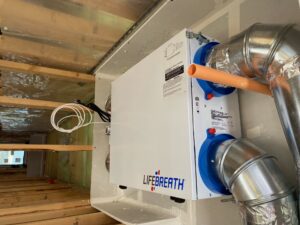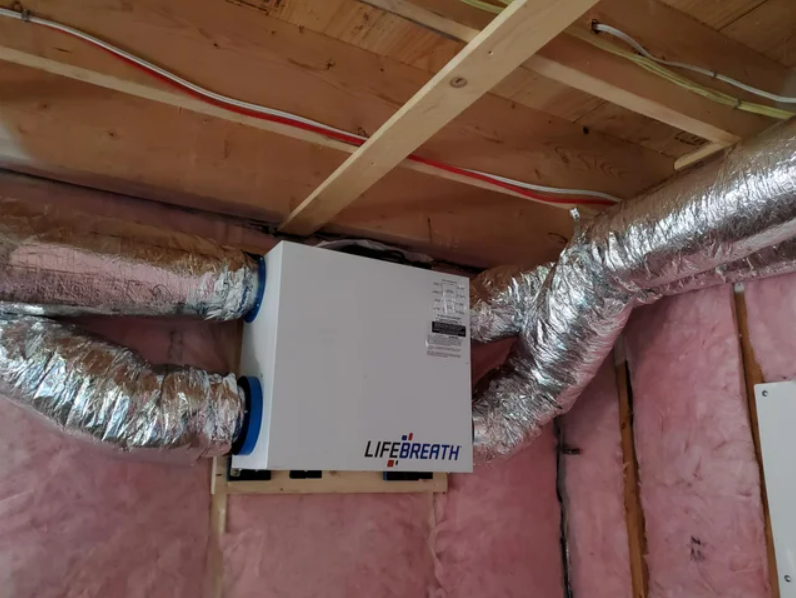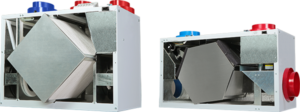In modern-built homes, ventilation is crucial, especially as homes become more energy-efficient and airtight. Lack of ventilation can lead to poor indoor air quality, such as moisture build-up, growth of mold, and accumulation of airborne pollutants.
That is where Heat Recovery Ventilators (HRVs) and Energy Recovery Ventilators (ERVs) come into play. These systems help maintain a balanced, healthy indoor environment by exchanging stale indoor air with fresh outdoor air.
But how do you choose between an HRV and an ERV, and how do you select the right unit for your home? This guide will walk you through the steps necessary to make the best choice for your needs.
Step 1: Understand the Basics – HRV vs. ERV
Before selecting a unit, it is essential to understand the fundamental differences between HRVs and ERVs.
- Heat Recovery Ventilator (HRV): This system exchanges stale indoor air with fresh outdoor air while transferring heat from the outgoing air to the incoming air. This process helps retain heat during colder months, improving energy efficiency without sacrificing ventilation.
- Energy Recovery Ventilator (ERV): Like an HRV, an ERV also exchanges stale air with fresh air, but it goes one step further by transferring both heat and moisture. In the winter, it transfers moisture from the outgoing air to the incoming dry air making your home more comfortable, and in the summer, it helps to reduce humidity by transferring moisture to the outgoing air reducing your cooling costs.
Which one should you choose?
- If you live in a cold, dry climate in the winter and a hot dry climate in the summer an HRV might be a better option since there isn’t any moisture to transfer.
- Many northern climates have high humidity levels in the summer months and are dry in the winter. An ERV may be a more energy-efficient and comfortable choice in these climates. If you’re installing an ERV in cold climate, ensure the ERV you choose is cold weather certified.
Step 2: Consider Your Home’s Size and Layout
The size and layout of your home will directly affect the capacity of the HRV or ERV you need. Most manufacturers specify the capacity of their units in terms of cubic feet per minute (CFM), which indicates how much air the unit can move.
- Calculate your Home’s Ventilation Needs: A common method is to ventilate using 0.35 air changes per hour (ACH) for your entire home. To calculate this, you will need to know the square footage and ceiling height of your home to estimate the volume of air that needs to be exchanged.
- Example Calculation: For a 2,000-square-foot home with 8-foot ceilings, the total volume is 16,000 cubic feet. At 0.35 ACH, you would need to exchange 5,600 cubic feet of air every hour. Dividing this by 60 minutes gives you a required ventilation rate of approximately 93 CFM.
Using an online CFM calculator will also help determine your unit size. Once you know your CFM requirement, look for HRV or ERV units that match or exceed this capacity. Please consult an HVAC professional to help you choose the appropriately sized unit.
Step 3: Assess Your Climate
The climate where you live plays a significant role in determining whether an HRV or ERV is the right choice for your home. Ask yourself the following questions:
Do I experience long, extremely cold winters?
- If yes, you will likely benefit from an HRV because it is designed to retain heat while ventilating your home.
Is my climate more humid, with hot, humid summers and less severe winters?
- An ERV may be more suitable here because it not only retains energy but also modulates humidity levels entering and exiting your home.
For homes in climates with both warm summers and cold winters, either an HRV or an ERV can work, depending on your specific needs. However, the ability of an ERV to manage humidity gives it an edge in many cases.
Step 4: Evaluate Installation Requirements
 Installing an HRV or ERV is more complex than simply placing a unit in your home. These systems are typically integrated into your home’s existing ductwork, although some units can function as standalone systems. You will need to consider:
Installing an HRV or ERV is more complex than simply placing a unit in your home. These systems are typically integrated into your home’s existing ductwork, although some units can function as standalone systems. You will need to consider:
- Ductwork: Does your home have existing ductwork that can accommodate an HRV or ERV? If not, you may need to install new ducts, which can increase the cost of the system.
- Space for Installation: HRV and ERV units are typically installed in basements, attics, or utility rooms. Ensure you have enough space for the unit and any associated ductwork.
- Professional Installation: Because these systems often integrate with your HVAC system, it is best to hire a professional installer to ensure the unit is properly set up and balanced.
Step 5: Check Energy Efficiency Ratings
Energy efficiency is a key consideration when choosing an HRV or ERV. Look for units that or another recognized energy efficiency program, such as HVI. If you live in a colder climate zone ensure the unit is Cold Weather Certified.
Higher efficiency units may cost more upfront, but they often pay for themselves over time through energy savings. Pay attention to the unit’s efficiency rating, which is usually expressed as a percentage. A higher percentage means better heat or energy recovery.
![]()

Step 6: Explore Additional Features
Modern HRV and ERV units come with a variety of features that can enhance their performance and convenience. Consider the following:
- Smart controls: Some units offer programmable settings, Wi-Fi connectivity, and integration with smart home systems, allowing you to control the ventilation remotely.
- Filters: Look for units with high-quality filters that can trap dust, pollen, and other airborne particles. Some units even include HEPA filters for better air quality.
- Quiet Operation: Noise can be a concern, especially if the unit will be installed near living areas. Check the decibel rating of the unit to ensure it operates quietly.
Step 7: Set Your Budget
The cost of an HRV or ERV system can vary widely, depending on the unit’s capacity, efficiency, and features. Installation costs will vary as well, particularly if new ductwork is required.
When setting your budget, remember to factor in long-term energy savings and the potential for improved air quality, which can reduce health issues related to poor indoor air.
Selecting the right HRV or ERV unit for your home is an investment in both your health and your home’s energy efficiency. By understanding the differences between HRV and ERV systems, assessing your climate, calculating your home’s ventilation needs, and evaluating installation requirements, you can make an informed decision. Do not forget to consider energy efficiency ratings, explore additional features, and set a budget that balances upfront costs with long-term savings.
With the right system in place, you will enjoy fresh, clean air while maintaining a comfortable, energy-efficient home year-round. Be sure to consult with a qualified HVAC professional to help you make the right choice.

